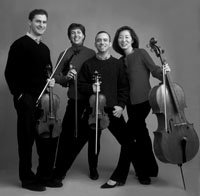György Ligeti Becomes "Blue Velvet" in the Hands of the Brentano Quartet
 When I first raved about the sublime recording of Mozart sonatas for piano and violin (with Mitsuko Uchida – no. 2 on my “Best of 2005 List”), I got scoffed at by a reader for having professed ignorance as to who Mark Steinberg might be. I wasn’t quite so shocked myself not to have heard of him before – but all the same very glad to have filled that gap in my musical acquaintanceship. Now that faint knowledge of his existence was deepened a bit when Mr. Steinberg turned out to be the first violinist of the Brentano String Quartet that played at the Corcoran Gallery last Friday. Playing with him in that quartet are second violin Serena Canin, cellist Nina Maria Lee, and violist Misha Amroy and they took Haydn, Ligeti, and Beethoven to Washington.
When I first raved about the sublime recording of Mozart sonatas for piano and violin (with Mitsuko Uchida – no. 2 on my “Best of 2005 List”), I got scoffed at by a reader for having professed ignorance as to who Mark Steinberg might be. I wasn’t quite so shocked myself not to have heard of him before – but all the same very glad to have filled that gap in my musical acquaintanceship. Now that faint knowledge of his existence was deepened a bit when Mr. Steinberg turned out to be the first violinist of the Brentano String Quartet that played at the Corcoran Gallery last Friday. Playing with him in that quartet are second violin Serena Canin, cellist Nina Maria Lee, and violist Misha Amroy and they took Haydn, Ligeti, and Beethoven to Washington.Their Vivace assai from Haydn’s op. 64, no. 3, was highly animated in a group the dynamics of which run along diagonal axes: from Mr. Steinberg to Ms. Lee jump around like salmon up-river; Ms. Canin and Mr. Amory less so and seemingly despite themselves. Still, any of those four players moved more in that Haydn Vivace than, say, the Brodsky Quartet in an entire evening. Most of that energy went to good use and set the groundwork for a hard drive through the rest of the work. The Adagio brought out some particular fine sounds from the viola.
György Ligeti’s string quartets have had a good run in D.C. – it is the third time I’ve heard one in the last year alone, but this was the first time I've taken in the second quartet in a while. The way the Brentano quartet played it, however, I imagine that even Métamorphoses nocturnes would have been unlike anything I’ve ever heard before. The Brentano conjured an incredible variety of colors and percussive effects. It was most unnerving and eerie, most theatrical: a performance rather than just ‘music, played’. The notes became microscopic ants that crawled into the listeners’ ears, and the level of infinite detail was baffling. The Brentano players turned Ligeti into an aural David Lynch film and not a soul – regardless of age – was unmoved.
 L.v.Beethoven, String Quartets opp.132 & 135, Brentano String Quartet æon     |
Beethoven’s op. 132 might have been the highlight of the evening – but if that had been the quartet’s aim, they did themselves no favor performing the Ligeti to such a riveting form of perfection that even the greatest performance of the A minor quartet would have struggled to compare. And while theirs was good –- extraordinarily dynamic –- it didn’t quite light the same fire. Their Beethoven was of the kind currently in favor: in an aggressive manner that enhances the topography of the music (higher highs, lower lows, accentuation and exclamation marks everywhere). As such it is quite unlike the melodiously sung way of playing these quartets (which can have a tempering influence on their severe nature) found with the Quartetto Italiano or Vegh and unlike, too, the mathematical, overly (?) controlled or somber approaches (à la ABQ or Emerson). The foremost exponent of the aggressive style is the Takács Quartet, who make the most out of it by applying it judiciously and not taking it to the extremes. I suspect that by and large we’ll trend away from that style over the next few years, but that doesn’t mean we can’t enjoy these interpretations while they are here in the thick.
The slow movement was, despite the Brentano’s situ as an “Action-Quartet,” the best of the five movements. By then Steinberg had worked out the uncharacteristic kinks that still plagued the first two, the players allowed the four voices to melt together in the Molto adagio and carried that coherence into the more animated Andante. Minor accidents aside and histrionics overlooked, the Alla marcia, assai vivace was electrifying; the Allegro appassionata rained fire. The Brentano Quartet may not be particularly young, but it was good to have heard late Beethoven done well, again.






















































